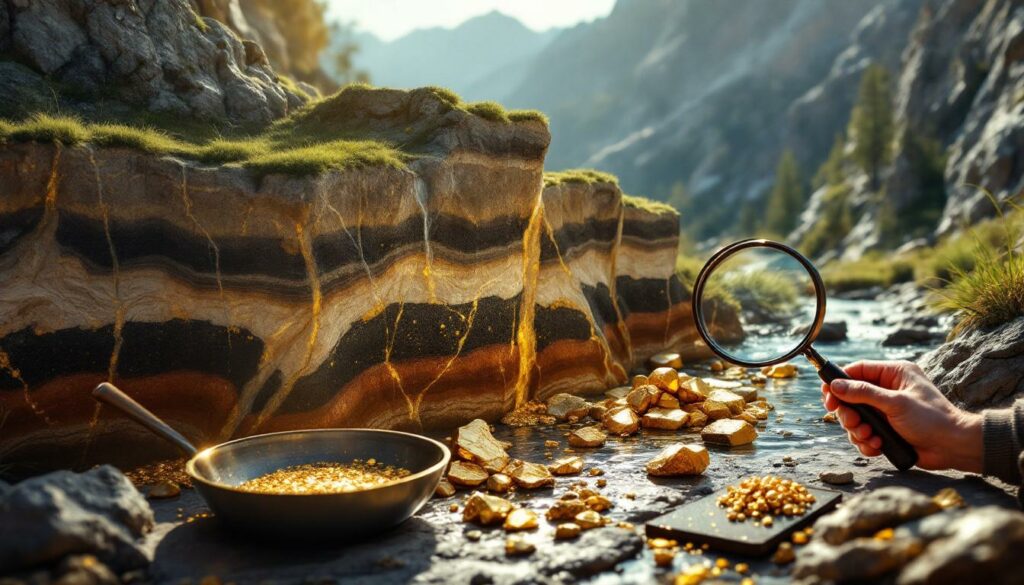Why Is Gold Rock Identification Important?
The Rarity Challenge of Gold Prospecting
Gold rarely appears in its pure form across landscapes, making random searching inefficient and frustrating. Instead, this precious metal typically embeds itself within specific host rocks under particular geological conditions, requiring targeted exploration techniques.
According to the USGS, less than 5% of quartz veins contain economically viable gold concentrations, highlighting why random searching yields poor results.
Economic and Time-Saving Benefits
Developing rock identification skills dramatically increases prospecting success rates while reducing wasted effort. Whether you're involved in commercial mining operations, scientific research, or weekend prospecting adventures, the ability to recognize potential gold-bearing formations can transform your results.
Studies from the Australian Bureau of Statistics show that prospectors using systematic geological identification approaches find productive sites up to 4 times faster than those using random methods.
Beyond the Gold Rush Myths
Modern prospecting requires scientific knowledge rather than luck. As geologist John R. Craig notes, "The most successful prospectors today aren't the luckiest—they're the most knowledgeable about where gold forms and how to recognize its geological signatures."
Understanding the geological indicators and mineral exploration importance provides a systematic approach that separates successful prospectors from those who return empty-handed.
What Are the Primary Gold-Bearing Rock Types?
Quartz Veins: Gold's Most Common Host
Quartz veins form when mineral-rich hydrothermal fluids infiltrate rock fractures, cooling and depositing both silica and precious metals. These formations appear as distinctive white to milky streaks cutting through darker host rocks, ranging from thin stringers to massive veins.
Research by Henley & Berger (2011) shows that these hydrothermal systems concentrate gold at specific pressure-temperature conditions, explaining why not all quartz veins contain gold.
Key identification features:
- White to translucent crystalline appearance
- Often shows iron staining (rusty reds and browns)
- May contain visible gold specks in exceptionally rich samples
- Frequently exhibits a banded or layered structure
Metamorphic Hosts: Schist and Gneiss
These foliated rocks form under intense tectonic pressure and heat, creating layered structures that can trap gold deposits. The mineral alignment in schists and gneisses often guides hydrothermal fluids, concentrating gold along specific pathways.
Identifying characteristics:
- Distinct layering and foliation patterns
- Presence of minerals like biotite, muscovite, and garnet
- Gold typically occurs along shear zones or foliation planes
- Often displays a shimmering or reflective quality due to mica content
Greenstone Belts: Ancient Gold Repositories
These metamorphosed volcanic-sedimentary sequences represent some of Earth's oldest and most productive gold-hosting environments. Their distinctive green coloration comes from minerals like chlorite, epidote, and actinolite.
According to de Ronde & de Wit (1994), these formations account for approximately 60% of the world's gold production, making them crucial targets for major mining operations.
Recognition features:
- Greenish hue in overall rock mass
- Often located in ancient continental cratons
- Typically associated with quartz-carbonate veins
- Frequently shows evidence of hydrothermal alteration
Serpentinite and Ultramafic Rocks
Formed through the metamorphism of mantle-derived rocks, serpentinites and related ultramafic formations can host significant gold deposits, particularly near fault zones or subduction boundaries.
Visual indicators:
- Smooth, sometimes waxy or greasy appearance
- Green to black coloration
- Often contains minerals like chromite, magnetite, and talc
- May display slickensided surfaces from fault movement
Banded Iron Formations (BIFs)
These distinctive Precambrian rocks consist of alternating layers of iron-rich minerals and silica. While not the most common gold hosts, some of the world's significant gold deposits occur within deformed or metamorphosed BIFs.
The Homestake Mine in South Dakota extracted over 40 million ounces from BIF-hosted deposits, demonstrating their significant potential (USGS, 2020).
Identification markers:
- Alternating bands of red/black iron minerals and lighter silica layers
- Often highly folded or contorted in gold-bearing zones
- Associated with sulfide mineralization in productive areas
- Ancient formations dating to Earth's early oxygen-producing era
How Can You Visually Identify Gold in Rocks?
Distinguishing True Gold from "Fool's Gold"
Many prospectors have been disappointed after mistaking pyrite (FeS₂) for gold. While both have a metallic luster, several key differences help distinguish them:
| Characteristic | Gold | Pyrite ("Fool's Gold") |
|---|---|---|
| Color | Rich yellow, buttery tone | Brassy yellow, paler |
| Crystal form | Irregular, rounded masses | Cubic or striated crystals |
| Streak | Yellow or no streak | Greenish-black streak |
| Hardness | Soft (2.5-3), can be scratched | Harder (6-6.5), difficult to scratch |
| Malleability | Bends and flattens when struck | Brittle, shatters when struck |
| Specific gravity | Very heavy (19.3 g/cm³) | Moderately heavy (5 g/cm³) |
As noted by mineralogists Klein & Dutrow (2007), "This density difference alone makes gold nearly four times heavier than pyrite, a distinction easily felt when comparing samples of similar size."
Telltale Surface Indicators
Several visual clues can suggest gold mineralization even when the metal itself isn't visible:
Iron Staining and Oxidation
Rusty red, yellow, or brown discoloration often indicates weathered sulfide minerals, which frequently accompany gold. These "gossans" or oxidized caps can point toward underlying mineralization.
Boxwork Textures
Honeycomb-like cavities or boxwork textures form when sulfide minerals weather away, leaving behind their distinctive geometric imprints. These structures often indicate environments favorable for gold deposit analysis.
The USGS photo library documents numerous examples of these textures from productive gold districts worldwide.
Manganese Coatings
Dark, sooty black stains on rock surfaces can signify manganese oxide coatings, which sometimes form in the same hydrothermal environments that deposit gold.
Quartz Characteristics
Not all quartz contains gold, but certain quartz features increase the likelihood:
- Vuggy or cavity-filled quartz
- Brecciated (broken and re-cemented) quartz
- Smoky or gray-tinted quartz
- Quartz with multiple generations of veining
What Tools Should You Bring for Field Identification?
Essential Equipment for the Modern Prospector
Effective field identification requires more than just a keen eye. These tools significantly enhance your ability to recognize gold-bearing rocks:
Optical Tools
- Hand lens (10x or greater): Allows detailed examination of mineral grains, textures, and potential gold specks
- UV light: Certain minerals associated with gold fluoresce under ultraviolet light
According to Rakovan (2003), minerals like scheelite and certain carbonates that often occur with gold show distinctive fluorescence under shortwave UV light.
Physical Testing Tools
- Rock hammer: Essential for breaking open rocks to expose fresh surfaces
- Streak plate: Unglazed porcelain for testing mineral streaks
- Magnet: Helps identify magnetic minerals like magnetite
- Field hardness kit: Contains reference minerals for hardness testing
- Small vials of dilute acid: For testing carbonate minerals (use with caution)
Documentation and Navigation
- Field notebook and pencil: For recording observations, locations, and sample details
- GPS device or smartphone: To mark promising locations precisely
- Digital camera: For documenting samples and geological contexts
Gold Recovery Tools
- Gold pan: For testing crushed rock or sediment samples
- Small sluice box: For processing larger amounts of material
- Metal detector: Useful for detecting near-surface gold nuggets in appropriate terrain
Where Should You Look for Gold-Bearing Rocks?
Prime Geological Settings for Gold Mineralization
Orogenic Belts and Mountain Ranges
Mountain-building processes create the pressure, heat, and fluid pathways necessary for gold concentration. Major gold provinces worldwide—from California's Sierra Nevada to Australia's Victorian Goldfields—occur in orogenic settings where tectonic plates have collided.
Research by Groves et al. (1998) established the orogenic gold model, explaining why these settings are so productive. Historical records show Sierra Nevada veins contained exceptional grades of 15-30 g/t Au (USGS Bulletin 1934).
Fault and Shear Zones
The crushing and grinding action along fault lines creates permeable pathways for mineral-rich fluids. Look for:
- Brecciated or fragmented rock
- Clay-rich alteration zones
- Slickensided surfaces (polished, striated rock faces)
- Linear features visible in the landscape
Ancient Riverbeds and Placer Deposits
Erosional processes concentrate heavy minerals like gold in specific depositional environments:
- Inside bends of streams and rivers
- Behind large boulders or natural obstructions
- Within gravel bars, especially at bedrock contact
- In ancient river terraces now above current water levels
NSW Resources (2022) reports typical alluvial gold recovery rates of 0.5-2 g/m³ in active streams with favorable bedrock conditions.
Volcanic-Related Systems
Volcanic activity drives hydrothermal systems that can concentrate gold:
- Near volcanic vents or calderas
- In areas with extensive hydrothermal alteration
- Around hot springs (modern or ancient)
- In epithermal vein systems with distinctive banded quartz
Simmons et al. (2005) describe how these epithermal systems create distinctive textures in quartz veins that serve as reliable indicators for gold exploration drilling.
What Simple Field Tests Can Detect Gold?
Practical Techniques for Preliminary Gold Identification
Panning Test
Gold panning remains one of the most effective field methods for detecting gold in crushed rock or sediment:
- Crush the rock sample to release any contained gold
- Place the material in a gold pan with water
- Agitate and wash away lighter materials
- Gold, due to its high density, will concentrate at the bottom
- Look for yellow metallic flakes or grains that remain
According to Murphy (2015), proper panning technique can achieve 70-90% gold recovery from a sample, making it reliable for field assessment.
Streak Test
The streak test helps distinguish gold from look-alike minerals:
- Rub the mineral across an unglazed porcelain plate
- Observe the color of the resulting streak
- Gold leaves a yellow streak or no streak at all
- Pyrite produces a greenish-black streak
- Chalcopyrite creates a dark green streak
Hurlbut & Sharp (1998) note that this simple test remains one of the most reliable field methods for mineral identification.
Specific Gravity Test
This test leverages gold's exceptional density (19.3 g/cm³):
- Weigh the dry sample
- Suspend the sample in water and weigh again
- Calculate specific gravity using the formula: SG = Weight in air ÷ (Weight in air – Weight in water)
- Gold and gold-rich samples will have significantly higher specific gravity than common rocks
As outlined by Shelley (2021), this approach requires minimal equipment while providing quantitative data.
Acid Test
Acid testing can help distinguish gold from other minerals:
- Apply a small drop of dilute hydrochloric acid to the mineral
- Observe any reaction (bubbling, color change)
- Gold remains unaffected by HCl
- Pyrite may slowly react, producing a sulfurous odor
- Carbonates will vigorously bubble and dissolve
Note: Always handle acids with proper safety equipment and follow OSHA guidelines for HCl use.
What Common Mistakes Do Beginners Make?
Avoiding the Pitfalls of Gold Prospecting
Mistaking Pyrite for Gold
The "fool's gold" error remains the most common mistake. A survey by the Gold Prospectors Association (2022) found this misidentification accounts for approximately 80% of beginner errors.
Remember that true gold:
- Is malleable rather than brittle
- Maintains its color in different lighting
- Appears less reflective than pyrite's mirror-like shine
- Doesn't form perfect cubic crystals
Assuming All Quartz Contains Gold
While quartz veins are important hosts, the vast majority contain no significant gold. Focus on quartz with:
- Iron staining or sulfide minerals
- Complex texturing or multiple generations
- Location in known gold-bearing districts
- Association with other indicator minerals
Hagemann et al. (2016) documented how this misconception led to numerous failed mining ventures during the 19th-century "Fool's Gold Rushes" in Colorado.
Ignoring Geological Context
Gold doesn't occur randomly—it follows geological rules. Prospectors who fail to consider the broader setting waste time in unproductive areas. Always ask:
- Is this area associated with known gold occurrences?
- Does the geological setting match productive gold environments?
- Are there structural features that could concentrate mineralization?
- Is there evidence of hydrothermal activity?
Poor Sample Documentation
Failing to record precise sample locations and geological observations makes it impossible to:
- Return to promising sites
- Recognize patterns of mineralization
- Build a systematic understanding of the area
- Share information effectively with others
How Do Real-World Gold Deposits Compare?
Case Studies of Famous Gold-Bearing Formations
Western Australia's Kalgoorlie Greenstone Belt
This world-class gold province has produced over 50 million ounces from deposits characterized by:
- Quartz-carbonate veins in metamorphosed basalts
- Association with major fault systems
- Presence of pyrite and arsenopyrite
- Extensive hydrothermal alteration halos
The Geological Survey of Western Australia (2021) continues to map extensions of this incredibly productive belt, which remains active after more than a century of mining.
California's Sierra Nevada Gold Belt
The famous "Mother Lode" region features:
- Quartz veins in metamorphic rocks (slate, schist)
- Strong structural control along major fault zones
- Association with serpentinite bodies
- Both primary vein gold and secondary placer deposits
South Africa's Witwatersrand Basin
The world's largest gold resource differs from typical vein deposits:
- Gold occurs in ancient conglomerate beds (fossil placers)
- Deposited in river deltas over 2.7 billion years ago (Frimmel, 2019)
- Fine gold disseminated throughout pebbly sediments
- Often associated with uranium minerals
The Chamber of Mines South Africa (2023) reports this single region has produced approximately 40% of all gold ever mined on Earth.
Canada's Abitibi Greenstone Belt
This prolific gold province contains:
- Narrow but extremely rich quartz veins
- Gold in altered volcanic rocks
- Strong association with porphyry intrusions
- Multiple styles of mineralization across the belt
Natural Resources Canada documents continuing production of approximately 10 Moz/year from this extraordinary geological province.
What Final Tips Will Improve Your Success Rate?
Strategic Advice for Amateur Prospectors
Research Before Fieldwork
Preparation dramatically increases your chances of success:
- Study geological maps of your target area
- Research historical mining activity nearby
- Join local prospecting groups for shared knowledge
- Understand the legal requirements for prospecting in your area
David Williams, author of Gem and Mineral Collecting (2020), emphasizes that "The most productive time in prospecting is often spent in the library, not in the field."
Develop a Systematic Approach
Rather than random searching:
- Focus on promising geological environments
- Sample methodically across different rock types
- Keep detailed records of all observations
- Return to productive areas for more intensive work
Build Your Identification Skills Progressively
Learning how to identify gold bearing rocks is a skill developed through practice:
- Start by learning to recognize common host rocks
- Practice distinguishing gold from look-alikes
- Develop familiarity with associated minerals
- Gradually build understanding of geological contexts
Prioritize Safety and Ethics
Responsible prospecting requires:
- Obtaining proper permissions before entering land
- Minimizing environmental impact
- Working with partners in remote areas
- Carrying appropriate safety equipment
- Respecting claim boundaries and regulations
Frequently Asked Questions About Gold-Bearing Rocks
Can I find gold in my backyard?
While technically possible, finding gold requires the right geological conditions. Unless you live in a known gold district with appropriate rock types, significant gold discoveries in residential areas are extremely rare.
What does raw gold look like in rock?
In rock, gold typically appears as irregular, yellow metallic
Want to Invest in the Next Major Mineral Discovery?
Discover significant ASX mineral discoveries as they happen with Discovery Alert's proprietary Discovery IQ model, which instantly transforms complex mineral data into actionable investment insights. Explore why major mineral discoveries can lead to substantial market returns by visiting Discovery Alert's dedicated discoveries page and begin your 30-day free trial today.




